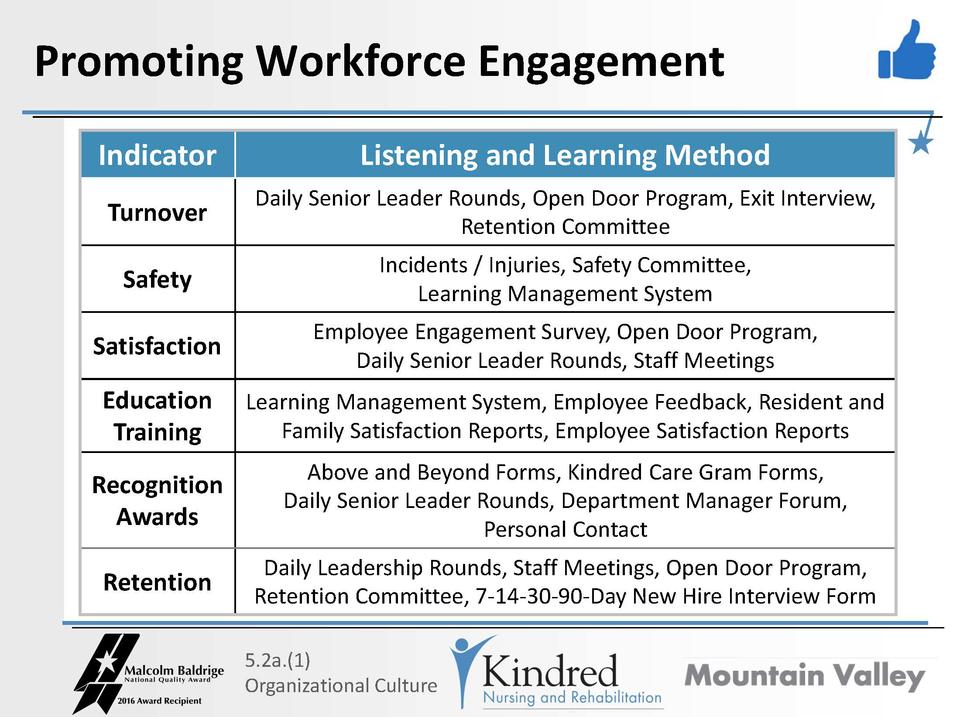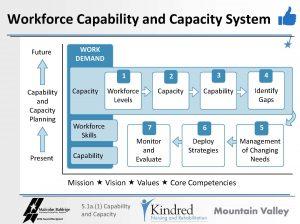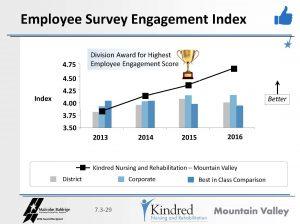Blogrige
The Official Baldrige Blog

By 2022, the Bureau of Labor Statistics predicts that in the United States 19.4 percent more registered nurses (RNs) will be needed to fill vacancies to care for our population, including an increasingly aging population. In addition, our health care organizations will need 21.1 percent more nursing assistants, 48.5 percent more home health aides, and 24.8 percent more licensed practical nurses (LPNs) and vocational nurses.
But at Baldrige Award recipient Kindred Nursing and Rehabilitation - Mountain Valley, some registered nurses drive as far as 40 miles to work there—even though it is not the highest paying health care center in the area, and a “grow-your-own” philosophy has resulted in LPNs training to be RNs, nursing aides training to be LPNs, and even some housekeepers training to be nursing aides.
What’s the secret? According to Jodi Hagaman, director of nursing service, speaking to a Baldrige Quest for Excellence© Conference audience, the nursing and rehabilitation center truly values its workforce and creates a culture of safety, empowerment, innovation, excellence, and no fear. It also uses the Baldrige Excellence Framework and the feedback reports received from applying for the Baldrige Award and American Health Care Association (AHCA)/National Center for Assisted Living (NCAL) National Quality Award Program (based on Baldrige) to validate its strengths, and reveal and prioritize its opportunities for improvement.
The 68-bed, skilled nursing facility, located in Kellogg, Idaho, has 90 employees and 33 key volunteers. According to Hagaman, “We are not the highest paying center [in the area] by far, but [nurses] want to work with us because they have researched our culture and our reputation.”
Like the entire health care industry, Hagaman said that Kindred Nursing and Rehabilitation - Mountain Valley is challenged with the retirement of many of its staff members and with recruiting new staff and nurses that want to work in its rural environment in a formerly bustling silver mine town.
She said that the center has been more successful than most in “growing our own through our culture of excellence.” Growing this culture has meant using the Baldrige framework to guide a determination of the drivers of workforce engagement and then to develop strategies with action plans and goals to promote that engagement.
“Our employees want to feel safe. They do not want to work in an environment of blame [where] they would potentially end up spending most of their energy protecting themselves, not doing what is in the best interest of our organization,” she said. “In our center, staff are willing to speak up, to be honest, and have a positive approach.” Communication is our strength; we give our workforce the freedom and responsibility to be efficient, she added.
To accomplish its core competencies of a highly engaged workforce, resident/patient-centered care, and excellent customer service, Kindred Nursing and Rehabilitation - Mountain Valley has developed a Workforce Capability and Capacity System with seven steps. The system is also aligned with its mission, vision, and values and considers succession planning. “When you see things go bad in health care, it’s usually because of turnover,” said Hagaman.

Senior leaders at the center remain intimately involved in operations. Hagaman said that each morning during stand-up meetings, all senior leaders and nursing staff review data and any staffing concerns that may be felt in the next three–five days. Stand-up meetings are also used to discuss referrals and discharges and to ensure the center has appropriately trained staff for patients per day and prior to admission.
The management of changing needs occurs through a Learning and Development System, as well as through a Service Excellence Program, which was created after reading Baldrige opportunity for improvement feedback. Successes are celebrated at any opportunity, Hagaman said; for example, the center recently celebrated its 100 percent deficiency-free survey from the Idaho Department of Health, which requires each nursing and rehabilitation facility in the state to be thoroughly inspected and evaluated in areas such as safety, quality of care, patient rights, food service, nursing care, and administration.
In addition, Hagaman said frank, two-way communication with senior leaders has created an environment of credibility and openness, opening up a “code of trust within the workforce”; such a favorable environment is evident in employee engagement results. “How we create our culture of excellence is through a highly engaged workforce. . . . [We have a] culture of innovation that encourages workforce empowerment with no fear of retaliation,” she added.

About the author
Related Posts
Comments
- Reply





